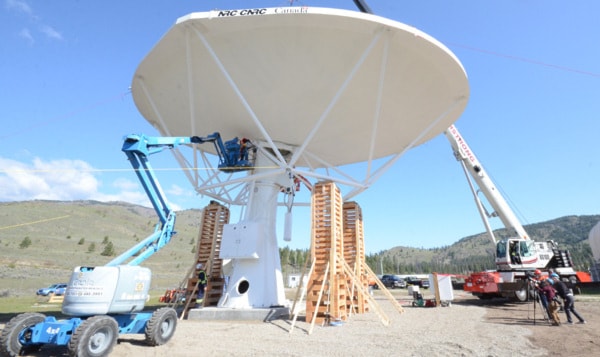There was a collective sigh of relief from National Research Council staff Wednesday morning as a crane delicately lowered the large radio telescope reflector onto its tower.
The $300,000, Canadian-designed and built carbon fibre dish gained international attention for all the wrong reasons last October when it was damaged in transit by helicopter from Okanagan Falls to the Dominion Radio Astrophysical Observatory (DRAO) grounds near White Lake.
“We’re pretty excited about this, especially after the last time we were out here,” said SKA (Square Kilometre Array) dish verification manager Gary Hovey, as the final bolts were tightened, locking the 195-square-metre device into place. “This is a really important event for us and for Canada. This is the first SKA prototype dish using the advanced technology we have. It puts us on the world stage, we’re back on track.
“Everything went really smoothly and we couldn’t be happier.”
Canada is one of the countries developing a dish to be used in three planned SKA projects in South Africa and Australia. At each site, 250 of the dishes will be combined to work as one giant radio telescope allowing scientists to go electronically where they have never gone before.Each fully assembled dish is expected to cost about$900,000. On this version, Canada has been working in conjunction with the American scientific community, which contributed mainly to the tower section. The dish mounted Wednesday was the same one damaged in the October incident, more good news for scientists.
“We were able to repair the dish and the surface accuracy which is one the key things that we’re after here and it’s just amazingly good,” said Hovey. “It’s within .9 mm of ideal so this is only about half a millimetre or so off, about the thickness of two or three sheets of paper.
“It proves our concept is very robust.”
Low production costs and high performance is the ultimate goal of those designing dishes. Someone else with a very vested interest in Wednesday success was Peter Dewdney.
“It is really quite exciting to see this, to see the dish and tower put into one piece. It’s been a long time coming. It’s an innovative design, it’s not like any that’s ever been done before,” said the scientist who has worked on the SKA concept since 1995.
“When this project is complete it will allow us to do early universe studies and one of the big areas of emphasis is surveying the Milky Way. Curiosity is what drives scientists, it’s like the early days of the explorers, they didn’t know what they would find and that’s why they were exploring. This is the same thing, only on a larger scale. It’s exploring the universe and where we came from.”
The task of actually doing the 12-metre long lift of the 8.7 tonne disk fell to Armstrong Crane and Rigging Inc.
Company operations manager Greg Nachtegaele was on the ground directing the efforts of his brother Cameron who was at the controls in the crane’s cab.
“Yes, I guess there was a bit of extra stress with this but we were confident we could do the job,” he said, referring to the fact there would be some very anxious onlookers hoping this time would be a smoother ride than the one last year. “This is a first for us, a satellite dish and it was a big and bulky item so it took a lot of planning and everything went just right.”
Although the use of the 3D Computer Lift computer program was invaluable, there were a number of variables such as wind conditions of soil compactness. The next step for DRAO scientists will be to add the remaining components to the dish, checking measurements and hopefully be able to put it into use this fall.
